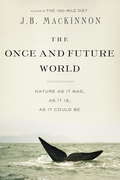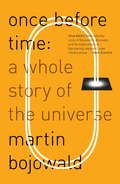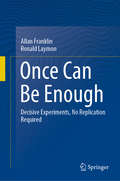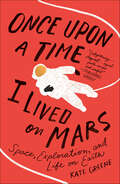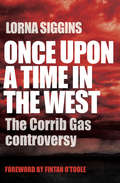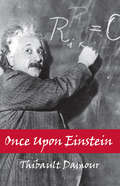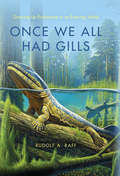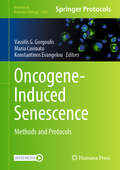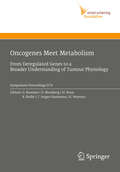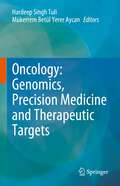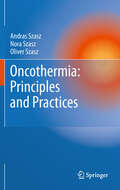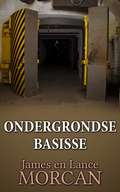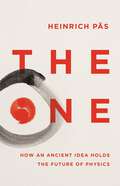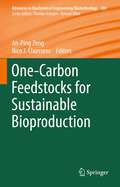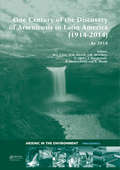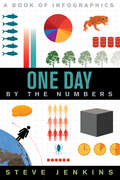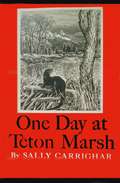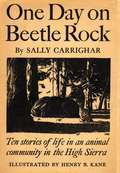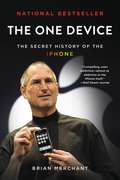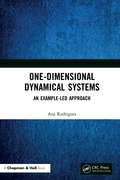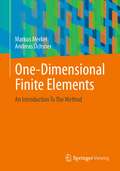- Table View
- List View
The Once and Future World
by J. B. MacKinnonFrom one of Canada's most exciting writers and ecological thinkers, a book that will change the way we see nature and show that in restoring the living world, we are also restoring ourselves. The Once and Future World began in the moment J.B. MacKinnon realized the grassland he grew up on was not the pristine wilderness he had always believed it to be. Instead, his home prairie was the outcome of a long history of transformation, from the disappearance of the grizzly bear to the introduction of cattle. What remains today is an illusion of the wild--an illusion that has in many ways created our world. In 3 beautifully drawn parts, MacKinnon revisits a globe exuberant with life, where lions roam North America and 20 times more whales swim in the sea. He traces how humans destroyed that reality, out of rapaciousness, yes, but also through a great forgetting. Finally, he calls for an "age of restoration," not only to revisit that richer and more awe-filled world, but to reconnect with our truest human nature. MacKinnon never fails to remind us that nature is a menagerie of marvels. Here are fish that pass down the wisdom of elders, landscapes still shaped by "ecological ghosts," a tortoise that is slowly remaking prehistory. "It remains a beautiful world," MacKinnon writes, "and it is its beauty, not its emptiness, that should inspire us to seek more nature in our lives."
Once Before Time: A Whole Story of the Universe
by Martin BojowaldBojowald recounts his discovery of loop quantum cosmology (LQC) and explains how it can illuminate the very birth of the universe.
Once Can Be Enough: Decisive Experiments, No Replication Required
by Allan Franklin Ronald LaymonThere has recently been considerable discussion of a “replication crisis” in some areas of science. In this book, the authors argue that replication is not a necessary criterion for the validation of a scientific experiment. Five episodes from physics and genetics are used to substantiate this thesis: the Meselson-Stahl experiment on DNA replication, the discoveries of the positron and the omega minus hyperon, Mendel’s plant experiments, and the discovery of parity nonconservation. Two cases in which once wasn’t enough are also discussed, the nondiscovery of parity nonconservation and the search for magnetic monopoles. Reasons why once wasn’t enough are also discussed.
Once Upon a Life Science Book: 12 Interdisciplinary Activities to Create Confident Readers
by Jodi Wheeler-ToppenWheeler-Toppen, a science teacher and children's author, presents 12 inquiry-based classroom lessons to help middle school teachers improve students' reading abilities and teach science content at the same time. Each lesson consists of a science activity, a reading about an important life science concept (easier to follow than those typically found in textbooks), an application that asks students to connect the activity with what they read, and a reading comprehension exercise, such as previewing illustrations, identifying text structures, and context clues to the meanings of new words. Each lesson also includes a graphic organizer and a writing activity. Six of the lessons ask students to make a claim and support it with evidence, and an introductory chapter suggests activities to help students understand claims and evidence.
Once Upon a Time I Lived on Mars: Space, Exploration, and Life on Earth
by Kate GreeneWhen it comes to Mars, the focus is often on how to get there: the rockets, the engines, the fuel. But upon arrival, what will it actually be like?In 2013, Kate Greene moved to Mars. That is, along with five fellow crew members, she embarked on NASA’s first HI-SEAS mission, a simulated Martian environment located on the slopes of Mauna Loa in Hawai'i. For four months she lived, worked, and slept in an isolated geodesic dome, conducting a sleep study on her crew mates and gaining incredible insight into human behavior in tight quarters, as well as the nature of boredom, dreams, and isolation that arise amidst the promise of scientific progress and glory.In Once Upon a Time I Lived on Mars, Greene draws on her experience to contemplate humanity’s broader impulse to explore. The result is a twined story of space and life, of the standard, able-bodied astronaut and Greene’s brother’s disability, of the lag time of interplanetary correspondences and the challenges of a long-distance marriage, of freeze-dried egg powder and fresh pineapple, of departure and return. By asking what kind of wisdom humanity might take to Mars and elsewhere in the Universe, Greene has written a remarkable, wide-ranging examination of our time in space right now, as a pre-Mars species, poised on the edge, readying for launch.
Once Upon a Time in the West: The Corrib Gas Controversy
by Lorna Siggins'All I want is to stay where I am . . . My heart and soul are in this place.'(Willie Corduff, one of The Rossport Five)In a remote, beautiful part of the west of Ireland, a David and Goliath struggle rages between multinational oil company, Shell, and some of the local community of Rossport, County Mayo. In 1996, Enterprise Oil, subsequently bought by Shell, found a major source of valuable gas offshore in the Corrib gas field. In the attempt to build an onshore pipeline and refinery the oil giant has come into conflict with a small group of locals who, anxious about the safety of their families, the environmental impact of the project and the future of their community, are resisting Shell's plans. The eyes of the nation fell on this tiny community when, in 2005, five of the residents were jailed for refusing to allow Shell onto their land, in contempt of court orders. These men have become known as The Rossport Five.Irish Times correspondent Lorna Siggins has been covering the controversy from the beginning. No one is better placed to unravel the twists and turns of this fascinating human drama and its political, cultural and environmental shockwaves. In a new Ireland where economic logic goes largely unchallenged, the Corrib Gas pipeline controversy raises uncomfortable questions about the ways in which Ireland has changed.
Once Upon Einstein
by Thibault DamourIt is well known that Einstein founded twentieth-century physics with his work on relativity and quanta, but what do we really know about these ground breaking ideas? How were they discovered? What should we retain today from the conceptual upheavals he initiated? Through a selection of concrete scenes taken from Einstein's life, the author offers
Once Upon A Starry Night: A Book Of Constellations
by Christina Balit Jacqueline MittonNational Geographic’s stunning rendition of the constellations’ glittering lightshow is now available in paperback. Take an illuminating ride through the starry night sky, and learn how the heavens pay tribute to the gods of Greek and Roman mythology. Once Upon a Starry Night explains the ten ancient figures whose legends are written large across the universe. Every page shines with Christina Balit’s vibrant art, studded with shiny stars, and provides the perfect backdrop to Jacqueline Mitton’s poetic text.
Once We All Had Gills
by Rudolf A. RaffIn this book, Rudolf A. Raff reaches out to the scientifically queasy, using his life story and his growth as a scientist to illustrate why science matters, especially at a time when many Americans are both suspicious of science and hostile to scientific ways of thinking. Noting that science has too often been the object of controversy in school curriculums and debates on public policy issues ranging from energy and conservation to stem-cell research and climate change, Raff argues that when the public is confused or ill-informed, these issues tend to be decided on religious, economic, and political grounds that disregard the realities of the natural world. Speaking up for science and scientific literacy, Raff tells how and why he became an evolutionary biologist and describes some of the vibrant and living science of evolution. Once We All Had Gills is also the story of evolution writ large: its history, how it is studied, what it means, and why it has become a useful target in a cultural war against rational thought and the idea of a secular, religiously tolerant nation.
Oncogene-Induced Senescence: Methods and Protocols (Methods in Molecular Biology #2906)
by Vassilis G. Gorgoulis Maria Cavinato Konstantinos EvangelouThis volume explores a collection of the most recent experimental approaches for the detection, modelling, characterization, and in-depth computational analysis of the biological phenomenon known as Oncogene-Induced Senescence (OIS). The chapters in this book cover topics such as protocols to study OIS in two-dimensional, three-dimensional, and in vivo (animal and human) settings; analyzing OIS using high-throughput bioinformatics; and discriminate OIS from aging. Published in the highly successful Methods in Molecular Biology series format, chapters include introductions to their respective topics, lists of the necessary materials and reagents, step-by-step and readily reproducible laboratory protocols, and tips on troubleshooting to avoid known pitfalls.Comprehensive and authoritative, Oncogene-Induced Senescence: Methods and Protocols is a valuable resource for basic researchers and clinicians in the oncology field, and a great guide for computational scientists.
Oncogenes Meet Metabolism
by Dominik Mumberg Thomas Steger-Hartmann Björn Riefke Guido Kroemer Kirstin Petersen Kector KeunIn 1920s, Otto Warburg described the phenomenon of 'aerobic glycolysis', the ability of tumour cells to convert glucose to lactate in the presence of normal oxygen conditions. Warburg's hypothesis of an altered metabolism in cancer cells found no immediate acceptance, though it was latter confirmed for most human tumours. With the advent of molecular biology the focus in tumour research has shifted towards the search for oncogenes. However, the interest in cancer molecular profiling eventually led to a renaissance of the Warburg effect trying to combine genetic alterations with effects on metabolism with the help of modern analytic technologies to rapidly analyze broad varieties of metabolites in various tissues and bodyfluids (metabonomics).
Oncology: Genomics, Precision Medicine and Therapeutic Targets
by Hardeep Singh Tuli Mükerrem Betül Yerer AycanThis book describes translational cancer therapeutics and the way forward from clinical and molecular diagnosis to treatment. In addition, genomics alterations, microRNAs, and long non-coding RNAs translate precision medicine for the individualistic therapy of cancer patients. It describes the involvement of various pharmacogenetic factors in pharmacodynamic/pharmacokinetic (PD/PK) modulations of medicines. Indeed, the role of bioinformatics and biostatistics, considering the extensive data analysis serving precision medicine approaches, has also been entertained in the present book. Therefore, intended book demonstrates the successful medical evidence for the use of precision medicine in the treatment of cancer and its future clinical perspectives. It fills the gaps in cancer biology and precision medicine with its up-to-date content and well-designed chapters. It will serve as a valuable resource for science, medical students, and interdisciplinary researchers. It is a very welcome addition for the scientific community, research centers, and university-industry research collaborators to find out a complete capsular package about cancer drug targets, precision, and personalized medicine (including an introduction to cancer cell signaling, genomic alterations, miRNA targeting, pharmacogenetics, biomarkers, and metabolomics in precision medicine, etc.) at a single platform.
Oncothermia: Principles and Practices
by Andras Szasz Nora Szasz Oliver SzaszOncothermia is the next generation medical innovation that delivers selective, controlled and deep energy for cancer treatment. The basic principles for oncothermia stem from oncological hyperthermia, the oldest approach to treating cancer. Nevertheless, hyperthermia has been wrought with significant controversy, mostly stemming from shortcomings of controlled energy delivery. Oncothermia has been able to overcome these insufficiencies and prove to be a controlled, safe and efficacious treatment option. This book is the first attempt to elucidate the theory and practice of oncothermia, based on rigorous mathematical and biophysical analysis, not centered on the temperature increase. It is supported by numerous in-vitro and in-vivo findings and twenty years of clinical experience. This book will help scientists, researchers and medical practitioners in understanding the scientific and conceptual underpinnings of oncothermia and will add another valuable tool in the fight against cancer. Professor Andras Szasz is the inventor of oncothermia and the Head of St Istvan University's Biotechnics Department in Hungary. He has published over 300 papers and lectured at various universities around the world. Dr. Oliver Szasz is the managing director of Oncotherm, the global manufacturer and distributor of medical devices for cancer treatment used in Europe & Asia since the late 1980s. Dr. Nora Szasz is currently a management consultant in healthcare for McKinsey & Co.
Ondergrondse Basisse
by Elmarié Smal James Morcan Lance MorcanWat vang die wêreld se supermagte in hul geheime ondergrondse bunkers aan? Ondergrondse Basisse gee in die besonder bevestigde en gerugte ondergrondse fasiliteite in die Verenigde State en regoor die wêreld. Dit bevat seldsame fotografiese bewyse dwarsdeur sowel as minder bekende aanhalings uit sleutelregeringsfigure. Dit maak 'n dwingende saak dat daar 'n enorme verborge wêreld onder die Aarde se oppervlak bestaan. Die Morcans spekuleer dat die bedekte ondergrondse infrastruktuur veel groter kan wees as wat voorheen vermoed is en waarskynlik gebruik word vir die ontwikkeling van onderdrukte tegnologie. Hul bronne sluit in verwyderde lêers, universiteitsverslae, WikiLeaks se dokumente en onderhoude met oud-militêre personeel wat verklikkers geword het, wat beweer dat hulle in "stede onder die grond" gewerk het. Ondergrondse basisse lewer 'n wye verskeidenheid feite en teorieë wat uiteindelik lesers toelaat om hul eie gevolgtrekkings te vorm. Die onthulling dek alles van: die Amerikaanse Departement van Verdediging se bevestigde ontruimingsgebiede onder die Wit Huis en die Pentagon, sowel as hul erkende terreine by Mount Weather en Cheyenne Mountain; Ondergrondse fasiliteite regoor die wêreld, insluitend Rusland se uitgestrekte Mezhgorye-kompleks en Australië se CIA-bestuurde Pine Gap; Die langvergete koerantopskrifte wat berig het dat Adolf Hitler en senior SS-beamptes na die Tweede Wêreldoorlog 'n Nazi-kolonie onder Antarktika kon gebou het; Gerugte dat menslike-ruimtewesens gesamentlike ondernemings onder die grond plaasvind en dat ontvoerde burgers in ondergrondse gevangenisse aangehou word vir onwettige mediese eksperimente soos kloning. Waarom spandeer die Globale Adelikes triljoene dollars van hul swart begrotings om sulke groot netwerke van ondergrondse (en ondersese en onderys) terreine te bou? Berei hulle bloot voor vir noodgevalle soos per amptelike regeringsverklarings? Glo hulle dat 'n Armageddon-scenario op hande is? Werk hulle in die gehei
The One: How an Ancient Idea Holds the Future of Physics
by Heinrich PäsA "fascinating [and] provocative" argument by a particle physicist—marshalling a "heady mix of history, philosophy and cutting-edge theory" (Wall Street Journal)—for monism, the ancient idea about the universe that says, All is One In The One, particle physicist Heinrich Päs presents a bold idea: fundamentally, everything in the universe is an aspect of one unified whole. The idea, called monism, has a rich three-thousand-year history: Plato believed that &“all is one&” before monism was rejected as irrational and suppressed as a heresy by the medieval Church. Nevertheless, monism persisted, inspiring Enlightenment science and Romantic poetry. Päs aims to show how monism could inspire physics today, how it could slice through the intellectual stagnation that has bogged down progress in modern physics and help the field achieve the grand theory of everything it has been chasing for decades. Blending physics, philosophy, and the history of ideas, The One is an epic, mind-expanding journey through millennia of human thought and into the nature of reality itself.
One- and Two-Dimensional Fluids: Properties of Smectic, Lamellar and Columnar Liquid Crystals
by Antal Jakli A. SaupeSmectic and lamellar liquid crystals are three-dimensional layered structures in which each layer behaves as a two-dimensional fluid. Because of their reduced dimensionality they have unique physical properties and challenging theoretical descriptions, and are the subject of much current research. One- and Two-Dimensional Fluids: Properties of Smec
One-Carbon Feedstocks for Sustainable Bioproduction (Advances in Biochemical Engineering/Biotechnology #180)
by An-Ping Zeng Nico J. ClaassensThis book offers a comprehensive review of the latest developments, challenges and trends in C1-based (one-carbon based) bioproduction, and it presents an authoritative account of one-carbon compounds as promising alternative microbial feedstocks. The book starts with a perspective on the future of C1 compounds as alternative feedstocks for microbial growth, and their vital role in the establishment of a sustainable circular carbon economy, followed by several chapters in which expert contributors discuss about the recent strategies and address key challenges regarding one or more C1 feedstocks. The book covers topics such as acetogenic production from C1 feedstocks, aerobic carboxydotrophic bacteria potential in industrial biotechnology, bioconversion of methane to value-added compounds, combination of electrochemistry and biology to convert C1 compounds, and bioprocesses based on C1-mixotrophy. Particular attention is given to the current metabolic engineering, systems biology, and synthetic biology strategies applied in this field.
One Century of the Discovery of Arsenicosis in Latin America: Proceedings of the 5th International Congress on Arsenic in the Environment, May 11-16, 2014, Buenos Aires, Argentina (Arsenic in the Environment - Proceedings)
by Marta I. Litter Hugo B. Nicolli Martin Meichtry Natalia Quici Jochen Bundschuh Prosun Bhattacharya Ravi NaiduThe Congress "Arsenic in the Environment" offers an international, multi- and interdisciplinary discussion platform for research aimed towards a holistic solution to the problem posed by the environmental toxin arsenic, with considerable societal impact. The congress has focused on cutting edge and breakthrough research in physical, chemical, toxic
One Day: By the Numbers (By the Numbers)
by Steve JenkinsWhat happens around in the world in twenty-four hours? Award-winning author-illustrator Steve Jenkins shares tons of amazing facts, figures, and stunning infographs in this early reader perfect for curious kids. In this latest stunning, informative reader in Steve Jenkins' By the Numbers series, explore what happens around the world with humans, animals, and even microorganisms in just twenty-four hours. From how much humans eat and how far migrating animals travel in day to how often lightning strikes. One Day By the Numbers takes readers beyond the clock and into what twenty-four hours looks like on a massive scale.
One Day at Teton Marsh
by Sally CarrigharA book about wildlife and the environment around Teton Marsh.
One Day in the Alpine Tundra
by Jean Craighead George"An hour after sunrise on August 16th, a huge slab of rock slipped. It lay at 10,000 feet on the top of Rendezvous Mountain in the Teton Mountains of Wyoming. It had been cracking in the heat and cold for centuries, and now on August 16th at 7:20 A.M. was poised to fall. ... Below, on the fall line of the slab of rock, Johnny Moore was sleeping in his mountain tent in the grass of a meadow. ..." Other books by this author are available in this library.
One Day On Beetle Rock
by Sally CarrigharAn elegant and lively depiction of nine animals spending a spring day on Beetle Rock, a large expanse of granite in Sequoia National Park, One Day on Beetle Rock is a classic of American nature writing. Drawing on seven years of close observation and inspired by the work of natural scientists, Sally Carrighar wrote with exquisite detail, bringing readers to an exhilarating consciousness of the search for food and a safe place to sleep, the relationship between prey and predator, and the marvelous skills and adaptations of nature.
The One Device: The Secret History of the iPhone
by Brian Merchant"The One Device is a tour de force, with fast-paced edge and heaps of analytical insight." -Ashlee Vance, New York Times bestselling author of Elon Musk"A stunning book. You will never look at your iPhone the same way again." -Dan Lyons, New York Times bestselling author of DisruptedThe secret history of the invention that changed everything-and became the most profitable product in the world.Odds are that as you read this, an iPhone is within reach. But before Steve Jobs introduced us to "the one device," as he called it, a cell phone was merely what you used to make calls on the go.How did the iPhone transform our world and turn Apple into the most valuable company ever? Veteran technology journalist Brian Merchant reveals the inside story you won't hear from Cupertino-based on his exclusive interviews with the engineers, inventors, and developers who guided every stage of the iPhone's creation.This deep dive takes you from inside One Infinite Loop to 19th century France to WWII America, from the driest place on earth to a Kenyan pit of toxic e-waste, and even deep inside Shenzhen's notorious "suicide factories." It's a firsthand look at how the cutting-edge tech that makes the world work-touch screens, motion trackers, and even AI-made their way into our pockets.The One Device is a roadmap for design and engineering genius, an anthropology of the modern age, and an unprecedented view into one of the most secretive companies in history. This is the untold account, ten years in the making, of the device that changed everything.
One-Dimensional Dynamical Systems: An Example-Led Approach
by Ana RodriguesFor almost every phenomenon in physics, chemistry, biology, medicine, economics, and other sciences, one can make a mathematical model that can be regarded as a dynamical system. One-Dimensional Dynamical Systems: An Example-Led Approach seeks to deep-dive into α standard maps as an example-driven way of explaining the modern theory of the subject in a way that will be engaging for students. Features Example-driven approach Suitable as supplementary reading for a graduate or advanced undergraduate course in dynamical systems
One-Dimensional Finite Elements: An Introduction To The Method
by Markus Merkel Andreas ÖchsnerThe basic idea of this introduction to the finite element method is based on the concept of explaining the complex method using only one-dimensional elements. Thus, the mathematical description remains largely simple and straightforward. The emphasis in each chapter is on explaining the method and understanding it itself. The reader learns to understand the assumptions and derivations in various physical problems in structural mechanics and to critically assess the possibilities and limitations of the finite element method.The restriction to one-dimensional elements thus enables the methodical understanding of important topics (e.g. plasticity or composite materials), which a prospective computational engineer encounters in professional practice, but which are rarely treated in this form at universities. Thus, an easy entry - also into more advanced application areas - is ensured by the concept of (a) introduction to the basics (b) exact derivation with restriction to one-dimensional elements (and in many cases also to one-dimensional problems) (c) extensive examples and advanced tasks (with short solution in the appendix).For illustration purposes, each chapter is deepened with extensively calculated and commented examples as well as with further tasks including short solutions
